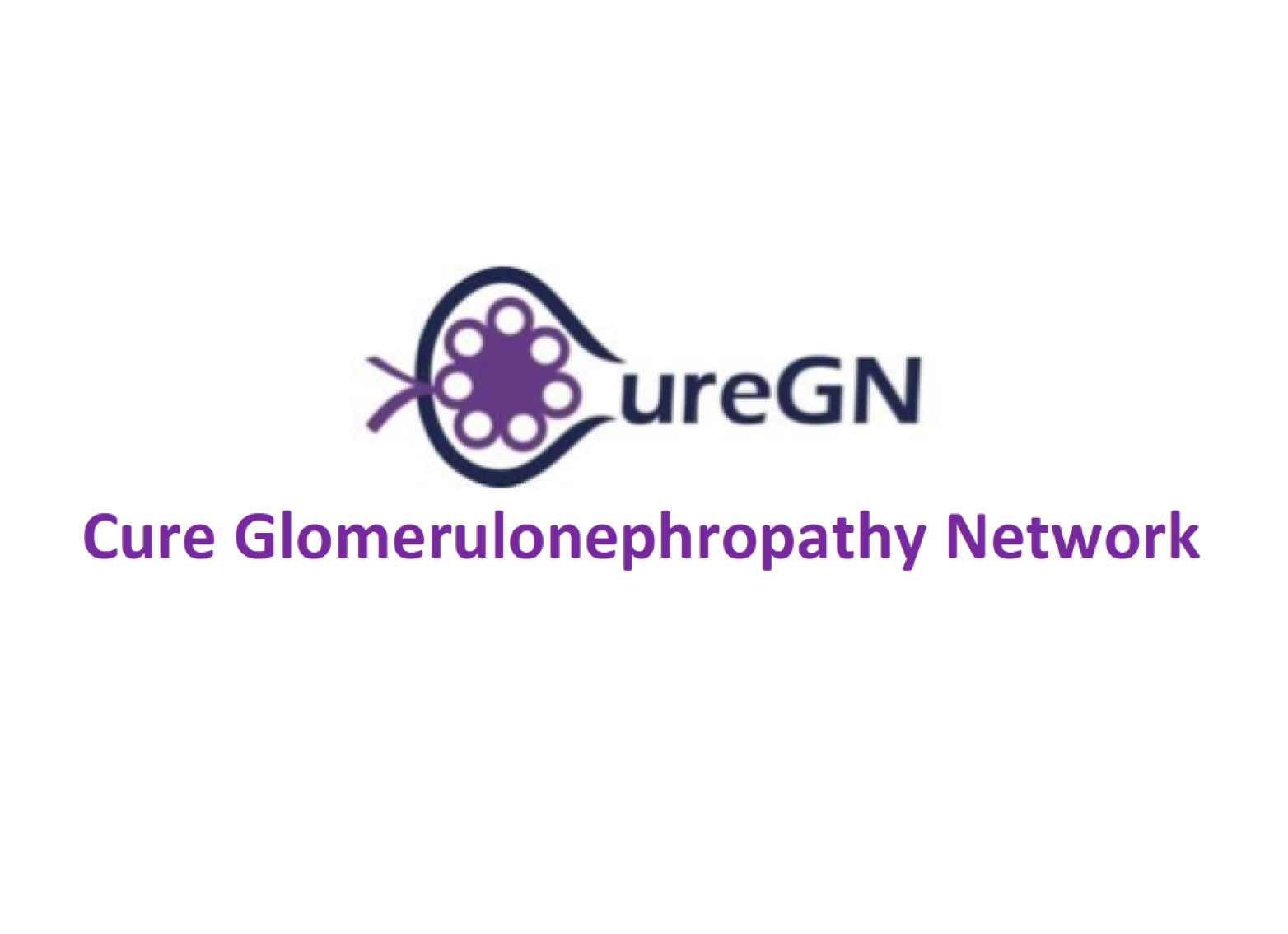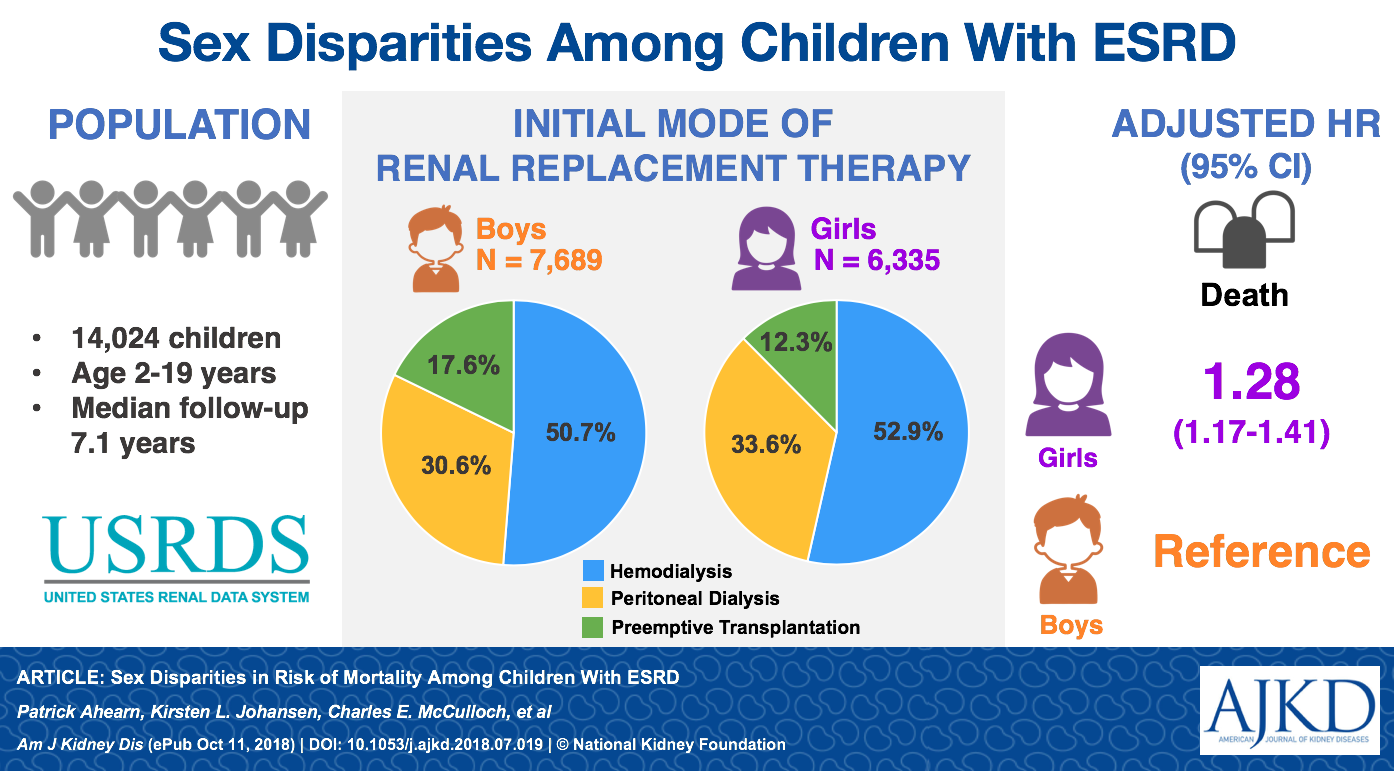Highlights from the February 2019 Issue
Editor’s Note: We asked authors of Original Investigations to provide short plain language summaries that would briefly summarize what inspired their study, the basic approach taken, what was learned, and why it matters. We hope our readers will find this valuable in helping them keep up with the latest research in the field of nephrology. From the February 2019 issue:
Sex Disparities in Risk of Mortality Among Children With ESRD by Patrick Ahearn et al
From the authors: Few studies have explored differences in survival after the development of end-stage kidney disease (ESKD) in girls compared to boys. In this study, we hypothesized that survival would differ for girls and boys receiving renal replacement therapy, and that this survival difference would be partially attributable to sex differences in access to transplantation. We found that girls have higher risk of death and lower access to transplantation, but that lower access to transplantation only partially accounted for the differences in survival among girls compared to boys. Further studies are needed to understand the sex differences in survival and access to kidney transplantation among children.
DOI: 10.1053/j.ajkd.2018.07.019
Editorial Sex Disparities in ESRD-Related Mortality: A Call to Action by Bethany J. Foster et al [FREE]
Risk Factors for Recurrent Acute Kidney Injury in a Large Population-Based Cohort by Kathleen D. Liu et al [FREE]
From the authors: Acute kidney injury (AKI) is a common problem in hospitalized patients that is associated with increased morbidity and mortality. In this large cohort study from Kaiser Permanente of Northern California, we sought to identify risk factors for a recurrent episode of AKI. In multivariable analysis, older age, black race and Hispanic ethnicity were associated with recurrent AKI, along with chronic kidney disease (either lower estimated GFR or proteinuria) and anemia. Heart failure, acute coronary syndrome, diabetes, and chronic liver disease, along with higher acuity of illness were also multivariable predictors of recurrent AKI. Recurrent AKI was associated with an increased risk of death. Taken together, our findings help to identify patients who may benefit from more intensive follow-up after a hospitalization with AKI.
DOI: 10.1053/j.ajkd.2018.08.008
Figure 2 from Liu et al, AJKD, © National Kidney Foundation.
Editorial Recurrent Acute Kidney Injury: Can We Differentiate From Nonrecovery and CKD Progression? by Etienne Macedo and Ravindra L. Mehta [FREE]
Identification and Prioritization of Quality Indicators for Conservative Kidney Management by Tyrone G. Harrison et al
From the authors: Patients with ESKD may choose to be treated with conservative kidney management (CKM) and not receive potentially life-prolonging treatment with dialysis when their health declines. However, what constitutes high-quality CKM is not well-understood. To help fill this gap in our knowledge, we engaged current CKM patients and caregivers from a single Canadian centre and a multidisciplinary group of healthcare professionals from ten countries worldwide. We developed a consensus-based list of 99 quality indicators that may be used in CKM delivery and program development or evaluation. Though high-quality CKM care was important to all groups, the priorities of healthcare professionals did not always align with those receiving CKM care.
DOI: 10.1053/j.ajkd.2018.08.014
Editorial The Donut or the Hole? Prioritizing Patient and Caregiver Values in the Delivery of High-Quality Medical Management Without Dialysis by Fahad Saeed et al [FREE]
Copyright: gwoeii / Shutterstock.com
Blog Post Deciding Not to Dialyze: What Comes Next? by Ed Gould [FREE]
Characteristics and Outcomes of Patients With Systemic Sclerosis (Scleroderma) Requiring Renal Replacement Therapy in Europe: Results From the ERA-EDTA Registry by Zdenka Hruskova et al
From the authors: Scleroderma is a rare chronic connective tissue disease with multi-organ involvement. There are limited published data on the outcomes of patients with end-stage renal disease (ESRD) secondary to scleroderma requiring renal replacement therapy (RRT), ie dialysis or kidney transplantation. In this European study we examined the incidence, prevalence of ESRD due to scleroderma and the clinical outcomes of 342 patients who received RRT for ESRD due to scleroderma between 2002 and 2013. We compared these outcomes to matched controls who either developed ESRD with a diagnosis of diabetes mellitus or with any other diagnosis except diabetes mellitus or scleroderma. Patients with scleroderma receiving RRT had a higher rate of recovering kidney function sufficiently to permit stopping RRE than observed in the matched control groups, though their overall survival was worse. Transplanted patients with scleroderma showed similar survival to the matched-controls, supporting the practice of kidney transplantation in these patients.
DOI: 10.1053/j.ajkd.2018.05.016
Psychosocial Health and Lifestyle Behaviors in Young Adults Receiving Renal Replacement Therapy Compared to the General Population: Findings From the SPEAK Study by Alexander J. Hamilton et al [OPEN ACCESS]
 From the authors: This study was undertaken to understand the effect of chronic kidney failure on the psychosocial health of young adults in the UK. We collected data from a survey which was linked to a disease register. Two-thirds of those approached responded to the survey. Approximately two-thirds were transplanted and a third were on dialysis. Compared to controls, we found impaired psychosocial health, with deficits in relationships, having children, independence, income, employment, quality of life, mental wellbeing, and mental health. Mental health problems appeared under-recognized, as we identified more through screening than were declared by participants. Young adults receiving dialysis or having had a kidney transplant reported healthier lifestyles than controls with less smoking, alcohol, drug abuse, and crime. This study provides strong evidence of important psychosocial disparities for young adults with kidney failure. It highlights areas for future study to further understanding and potential interventions to improve outcomes.
From the authors: This study was undertaken to understand the effect of chronic kidney failure on the psychosocial health of young adults in the UK. We collected data from a survey which was linked to a disease register. Two-thirds of those approached responded to the survey. Approximately two-thirds were transplanted and a third were on dialysis. Compared to controls, we found impaired psychosocial health, with deficits in relationships, having children, independence, income, employment, quality of life, mental wellbeing, and mental health. Mental health problems appeared under-recognized, as we identified more through screening than were declared by participants. Young adults receiving dialysis or having had a kidney transplant reported healthier lifestyles than controls with less smoking, alcohol, drug abuse, and crime. This study provides strong evidence of important psychosocial disparities for young adults with kidney failure. It highlights areas for future study to further understanding and potential interventions to improve outcomes.
DOI: 10.1053/j.ajkd.2018.08.006
Blog Post The Impact of RRT on Young Adults in the UK Author Interview with Alexander Hamilton [FREE]
Relationship of Estimated GFR and Albuminuria to Concurrent Laboratory Abnormalities: An Individual Participant Data Meta-analysis in a Global Consortium by Lesley A. Inker et al
From the authors: The kidney performs many functions in addition to filtering blood and excreting waste. People with poorly functioning kidneys can develop high blood pressure, anemia, and altered bone and mineral metabolism, which often require treatment. In this study of more than 50 cohorts and approximately 2 million people, we assess the risk of these conditions by level of kidney function (measured by the glomerular filtration rate) and kidney damage (measured by the amount of albumin in a person’s urine). We found that, in general, people with lower levels of kidney function but not higher levels of kidney damage, had higher blood pressure, anemia, and altered bone and mineral metabolism. This information may help doctors make individualized action plans for their patients.
DOI: 10.1053/j.ajkd.2018.08.013
CureGN Study Rationale, Design, and Methods: Establishing a Large Prospective Observational Study of Glomerular Disease by Laura H. Mariani et al
 From the authors: CureGN will study patients with the rare kidney diseases of minimal change disease (MCD), focal segmental glomerulosclerosis (FSGS), membranous nephropathy, and IgA nephropathy. Although patients with these conditions suffer from similar symptoms, their individual disease courses vary widely. By collecting information about study participants’ disease over time, along with their digital kidney biopsy images, blood, and urine specimens, CureGN aims to support research that will identify new ways to diagnose these diseases, classify patients into biologically-relevant subgroups, and more accurately predict outcomes, such as medication response and toxicity, loss of kidney function, and other disease complications, including blood clots and infections. CureGN is expected to be among the largest prospective studies of children and adults with these glomerular diseases. The study design and rationale is explained in this study description.
From the authors: CureGN will study patients with the rare kidney diseases of minimal change disease (MCD), focal segmental glomerulosclerosis (FSGS), membranous nephropathy, and IgA nephropathy. Although patients with these conditions suffer from similar symptoms, their individual disease courses vary widely. By collecting information about study participants’ disease over time, along with their digital kidney biopsy images, blood, and urine specimens, CureGN aims to support research that will identify new ways to diagnose these diseases, classify patients into biologically-relevant subgroups, and more accurately predict outcomes, such as medication response and toxicity, loss of kidney function, and other disease complications, including blood clots and infections. CureGN is expected to be among the largest prospective studies of children and adults with these glomerular diseases. The study design and rationale is explained in this study description.
DOI: 10.1053/j.ajkd.2018.07.020
Blog Post What is CureGN and How to Get Involved Author Interview with Michelle Rheault [FREE]
Technique Failure in a Multicenter Canadian Home Hemodialysis Cohort by Robert P. Pauly et al
From the authors: Discontinuation of home hemodialysis for reasons other than death or transplantation is an important clinical outcome and is termed technique failure. This study examined technique failure in seven Canadian home dialysis programs from 2000 to 2010 and found that technique failure and mortality differed among the Canadian home hemodialysis programs studied. The influence of a center on adverse outcomes is likely the cumulative result of a program’s policies, procedures, and philosophy of care. Center-to-center variation in outcomes suggests that where patients receive their care, including their training, treatment, and follow-up, influences the success of their home dialysis treatment regimen. These findings will stimulate additional investigations to understand how home dialysis programs can optimize patient outcomes.
DOI: 10.1053/j.ajkd.2018.08.016
On the Cover: Physicians have long appreciated the value of urine examination in medical diagnosis even prior to the advent of urine microscopy and modern urinalysis. This woodcut produced in the style of a work from the early 14th century shows a medieval medical dispensary in which several women wait for their urine to be analyzed by a doctor. This image reminds us not only of the long history of physicians examining urine, but also of the value it can bring to clinical care. The Core Curriculum in this month’s AJKD highlights the importance of nephrologists’ examination of urine as part of a comprehensive clinical evaluation:
Urine Sediment Examination in the Diagnosis and Management of Kidney Disease [FREE] by Corey Cavanaugh and Mark A. Perazella. Check out the author interview with Corey Cavanaugh.
Cover Image: “A medical practitioner examining urine brought by his patients,” a painted relief after Nino Pisano, is from the Wellcome Collection, available under a CC BY license.




Leave a Reply